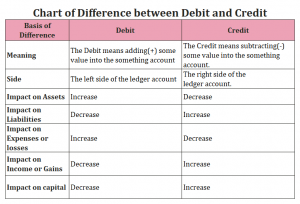Advertisement
The Debit and Credit are two aspects of the double-entry system, which is invented by “Luca Pacioli” the father of bookkeeping. According to the double-entry system, Every business transaction has impacted at least two accounts and which is recorded as the Debit one account and credit second account. The debit is shown on the left side of the accounts and Credit is shown on the right side of the account.
Advertisement
Debit Impact:-
In simple words, the Debit means adding some value into something account. It means when we Debited the account of assets it means we adding some value into it.
Example: –
we have the debit balance of Furniture account of 10,000/- When we have debited the account of assets or expenses, it shows the increase in these accounts and when we have debited the accounts of liabilities or capital, it shows the decrease in these accounts.
Credit Impact:-
Advertisement-X
When we have credited the account of assets or expenses, it shows the decrease in these accounts and when we have debited the accounts of liabilities or capital, it shows the Increase in these accounts.
Table presentation of the impact of Debit and Credit: –
| Impact on accounts | Debit | Credit |
| Assets or Expenses | Increase | Decrease |
| Income, Liabilities or Capital | Decrease | Increase |
Meaning of Debit:-
In simple words, the Debit means adding(+) some value into the something account. It means when we Debited the account of assets it means we adding some value into it.
Example: –
we have the debit balance(+) of Furniture account of 10,000/- and we purchase new furniture worth 5,000/- according to rules of accounting (Tradition and Modern), we will debit(+) the account of furniture. Now the total of the furniture account become 15,000/-(10,000 + 5000)) {(Because Debit + Debit ( “+” + “+”)}.
Meaning of Credit:-
In simple words, the Credit means subtracting(-) some value into something account. It means when we Credited the account of assets it means we subtracting(-) some value from it.
Advertisement-X
Example: –
we have the debit balance of Furniture account of 15,000/- and we Sold old furniture worth 5,000/- according to rules of accounting(Tradition and Modern), we will credit the account of furniture. Now the total of the furniture account become 5,000/-(10,000+ (-5000)) {Because Debit + Credit ( “+” + “-“)}.
Presentation of Debit and Credit in journal and ledger: –
Now, We will show the presence of these aspects in the journal and ledger by shows format images of journal and ledger as follows: –
The format of Journal: –

The format of Ledger: –

Chart of Difference between Debit and Credit: –
Basis of Difference | Debit | Credit |
Meaning | The Debit means adding(+) some value into the something account | The Credit means subtracting(-) some value into something account. |
Side | The left side of the ledger account | The right side of the ledger account. |
| Impact on Assets | Increase | Decrease |
| Impact on Liabilities | Decrease | Increase |
| Impact on Expenses or losses | Increase | Decrease |
| Impact on Income or Gains | Decrease | Increase |
| Impact on capital | Decrease | Increase |
Download the chart: –
If you want to download the chart please download the following image and PDF file:-

Conclusion: –
The debit and credit both are a very important aspect of accounting. Both have an impact on each and every business transaction. Without Debit and credit, we can not record the books of account.
Thanks for reading the topic of Difference between Debit and Credit, please comment your feedback whatever you want. If you have any question please ask us by commenting.
Advertisement-X
Check out T.S. Grewal’s +1 Book 2019 @ Official Website of Sultan Chand Publication













Leave a Reply